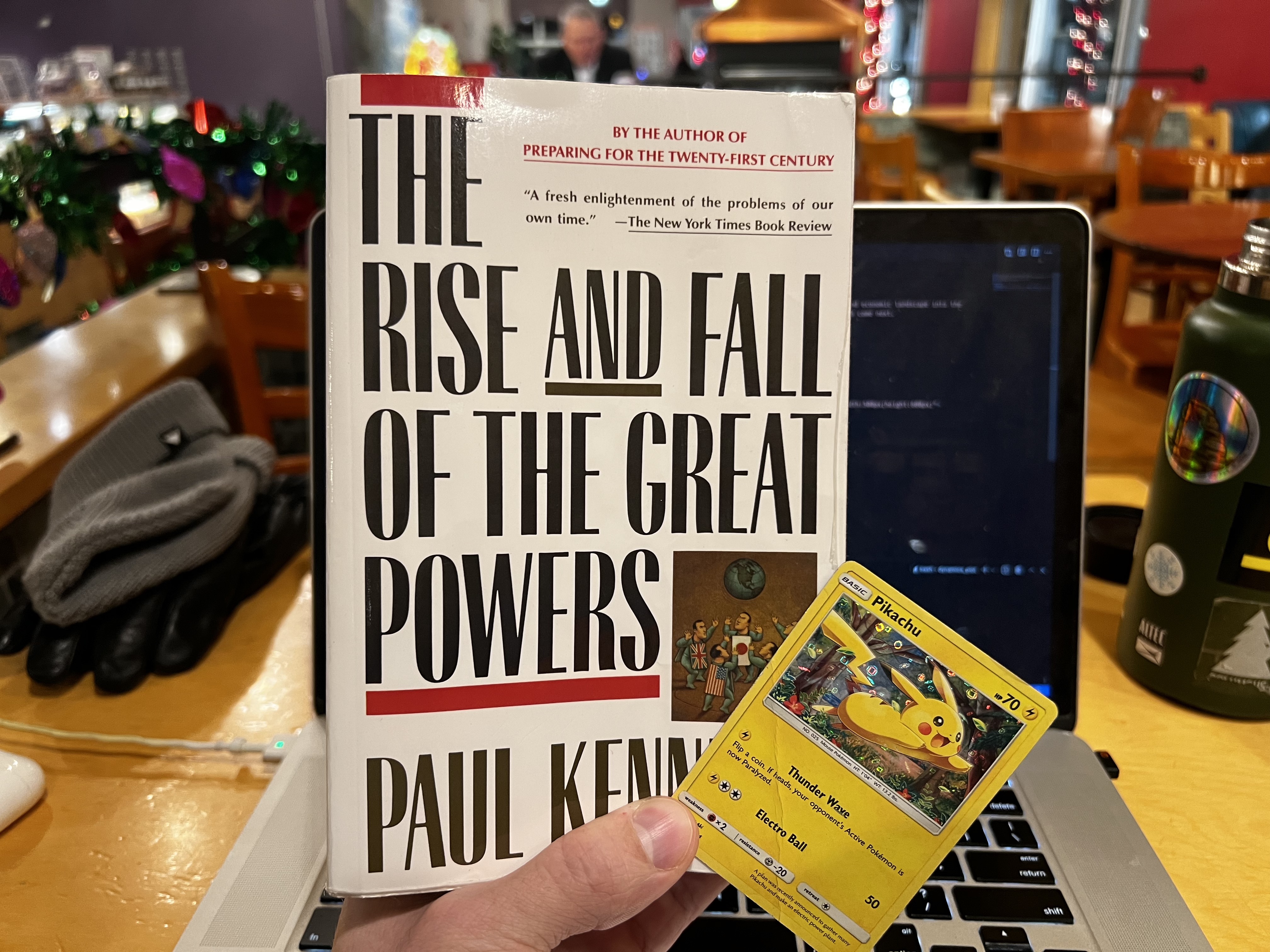World history is a daunting subject. Given that there are many different lenses through which one can view a given event, it’s often difficult to gain perspective and see the “big picture” of the world, its dynamics, and how the world order has been shaped over thousands of years of human history. This has been exacerbated in recent times, with a constant onslaught of news, headlines, and fill-in-the-blanks-“for our lives” obfuscating what is the signal among the noise.
Enter Paul Kennedy’s The rise and fall of the great powers. A truly Herculean work of over 500 pages, The rise and fall sets out to place modern world economic and power struggles into the context of the last ~500 years of world history. (Note that this book was published in 1987, so “modern” here is relative.)
The work begins in the pre-industrial age, focusing on Ming China, the Muslim World, Japan, Russia, and Europe; it proceeds to outline how Europe became the center of world power and economics prior to the Industrial Revolution through both rising European economic and military might and the numerous isolationist movements in her contemporaries. (Mr. Kennedy argues this was a massive blunder for China, and probably set its bid for world power back hundreds of years.)
From here, The rise and fall delves into European history, the truly striking number of wars fought on its soil, and how its economy and power landscape evolved prior to the Industrial Revolution and beyond it. Key points here are the Habsburg attempt and subsequent failure at European hegemony, Napoleon’s bid for French hegemony, and the relative rise of British power towards the beginning of the seventeenth century.
I use the word relative in the above because it is absolutely central to one component of Mr. Kennedy’s thesis: the world order is shaped by the relative strength of each contending member. This might seem intuitive to studied individuals of world history and power, but to me, a newcomer to the topic, I thought this was a deep and instructive point. Britain didn’t become a world power in the Industrial Age because she was strong in absolute terms necessarily, but rather because she was strong relative to each of her contemporaries she had to compete with economically and, in many cases, militarily. Applying this framework to the present-day, one could postulate that the decline of United States power in world affairs isn’t because of any absolute decline in economic power (the US economy is still massive in absolute terms and growing), but relative to her contemporaries, the US just isn’t as dominant as she was post-World War II.
Continuing with the scope of the book, it moves next to a discussion of the Industrial Age leading up to World War II, which was as compelling as the pre-Industrial Age discussion outlined above. Of particular note is Mr. Kennedy’s discussion of the Russian failure in the Crimean War, especially when compared to the Vietnam War and its consequences for American power in the 1960s later on in the book. (This part of the book also had a fair amount of fist-pumping to be done by American readers; just look at America’s war potential in comparison to the rest of the world in 1937 below, taken from p. 332. The US title of the “sleeping giant” in World War II was indeed earned!)
| Country | Relative War Potential |
|---|---|
| United States | 41.7% |
| Germany | 14.4% |
| USSR | 14.0% |
| U.K. | 10.2% |
| France | 4.2% |
| Japan | 3.5% |
| Italy | 2.5% |
The discussion of the world economic and power balance post-World War II outlines the “coming of the bipolar world,” where two great superpowers emerge: the United States and the Soviet Union. This part of the book was more familiar to me, although it is still absolutely striking and worrisome just how many nuclear weapons permeated the world at this time, and how these numbers aren’t exactly coming down in the world we currently live in.
Each of these individual discussions of world history culminates in the final ~75 pages, where Mr. Kennedy speculates to the future, focusing on Japan, China, Europe, the USSR, and the United States. Here we again find that prognosticating the future can be an unforgiving business (see my review of Ten billion for more evidence of this). Mr. Kennedy’s discussion of Japan becoming world number one, for example, is somewhat moot in light of the numerous Asian financial crises of the 1990s and early 2000s. Even more cruel is that the USSR collapsed in 1988, less than a year after Mr. Kennedy published this work.
However, this does not mean that Mr. Kennedy’s projections are without merit. He accurately discusses how without sufficient cooperation, Europe will struggle to contend with the US, China, Japan, and Russia; the European Union was formed in 1993, essentially validating Mr. Kennedy’s point six years after publication. His discussion of the United States and how challenging it would be to maintain world number one status while in relative decline is all too relevant to American politics today. Finally, his prediction that China would be a significant world player in the twenty-first century if it could learn from the mistakes of the USSR has been more or less spot-on.
Perhaps the best way to summarize Mr. Kennedy’s work here — if one could even attempt such a task, given the breadth and detail in the work — is in two themes. The first is that world power is established through both economic and military might. In great power conflicts, the nation/coalition with “the deepest purse” and strongest manufacturing base will win out, provided an initial blitz does not overwhelm the nation/coalition’s forces and no nuclear weapons are used. If nuclear weapons are on the table, it’s unclear how a nation’s manufacturing base would influence the conflict, given it could be wiped out in a matter of days by the opponent. But the theme of the nation with the more powerful productive base and deepest financial reserves is poised to have a significant advantage over its opponent, particularly in the long term, still holds in the present day.
The second theme is that world power governments throughout history have had to perform a careful balancing act: to balance military spending and productive investment. To overspend on the armaments, say in response to perceived danger or aggression from a rival, puts strain on the domestic economy and by definition detracts from productive investment in domestic firms and overall growth. However, to overspend on investment without properly bolstering the military could be taken advantage of by a rival nation who, in the meantime, has been bolstering their armed forces. Compounding this risk is the ever-growing cost of war, so to ramp up one’s armed forces in short order (like how the United States did for World War I) becomes more and more difficult as time goes on.
Mr. Kennedy’s writing in The rise and fall of the great powers has given me new perspective on world power and economics. The United States increasing military spending, for example, is no longer just “buying a few more ships” to me. It must be (at least in Mr. Kennedy’s framework) either a response to a threat by another world power perceived by the Pentagon, or a necessary expense to detract others from aggression. On the other hand, if the threat never materializes, it’s difficult to see increases in military spending as anything other than “dead money” that could’ve been used more wisely elsewhere. Certainly, The rise and fall has given me a new perspective on how Washington, and indeed, the world writ large, handles its budgets, its economies, and its militaries in the constant bid for world power and hegemony.
Overall, this is an important book for anyone interested in understanding how economics, war, and power are determined on the global scale. I’d highly recommend it.
Rating: As powerful as the Royal Navy, circa 1800.
Pokémon card for this book: I used Pikachu for this book because it was just my rotating bookmark for every book I read prior to changing the card for each book. Apologies for the crease, but I’m afraid I fell asleep numerous times reading this book. While impactful in retrospect, it’s not particularly riveting in real time to read about the umpteenth battle between the Habsburg Empire and the French!




